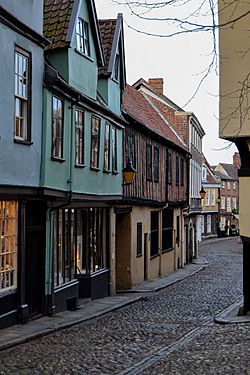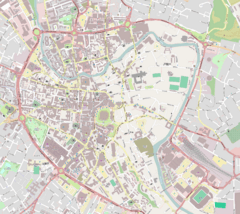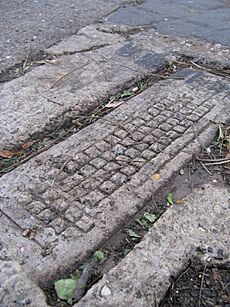Elm Hill, Norwich facts for kids

Elm Hill in 2018, looking east
|
|
| Maintained by | Norwich City Council |
|---|---|
| Coordinates | 52°37′54.4″N 1°17′49.6″E / 52.631778°N 1.297111°E |
Elm Hill, Norwich is a very old cobbled street in Norwich, Norfolk. Many of its buildings are from the Tudor period, which was a long time ago!
It's a well-known spot in Norwich. You can find cool places like the Briton's Arms coffee house and the Dormouse Bookshop here.
Because it looks so old and charming, Elm Hill has been used in movies and TV shows. It was featured in the 2007 film Stardust. It also appeared in Netflix's 2020 movie Jingle Jangle.
Contents
Discovering Elm Hill's Past
How Elm Hill Got Its Name
Elm Hill gets its name from the elm trees that have stood in the square for centuries. The first elm tree was planted way back in the 1500s. This was done by the people looking after St Peter Hungate Church.
The tree you see there today is not an elm. This is because of a disease called Dutch elm disease that affects elm trees in the UK. You'll also see a parish pump near the tree, though it's not the original one.
Early Days of Elm Hill
We don't know the exact date when Elm Hill first started. But there's proof it existed around the year 1200. Most of the buildings you see today are not older than 1507. This is because a huge fire in 1507 destroyed over 700 houses in Norwich.
The Britons Arms was the only building on Elm Hill to survive that fire. So, it is much older than the others!
Elm Hill used to go straight past the Britons Arms. It then met St Georges Street. But in the 1400s, the street was changed. This was to allow the building of St Andrew's & Blackfriars Halls. These halls were originally home to Dominican friars, who were a type of monk.
Today, Elm Hill stretches from the Church of St. Peter Hungate to the Church of St. Simon and St. Jude.
A Busy Trading Street
It might not look like it now, but the north side of Elm Hill runs next to the river Wensum. In the past, many merchant houses had their own docks. During the 1400s and 1500s, Elm Hill and the river were very important for business.
The river was used to bring in raw materials. Finished products were then sent out through Great Yarmouth. Norwich was very successful at this time. Many skilled workers like weavers, dyers, and goldsmiths came here from Europe.
Rich merchants lived in houses facing Elm Hill. Their factories and workshops were behind their homes. The people who worked for them lived between the factories and the river. Many people from Elm Hill became important leaders in Norwich, serving as Mayor or Sheriff.
Saving Elm Hill from Demolition
By the 1800s, Norwich's weaving industry started to decline. Elm Hill became less important and slowly turned into a neglected area. By 1926, the beautiful merchant houses were run-down. The areas near the river were in poor condition.
The Norwich Corporation, which was like the city council, wanted to knock down the north side of the street. They planned to build a swimming pool there. But at the last minute, they listened to ideas from the Norwich Society.
In 1927, the Norwich Society looked closely at Elm Hill. They wrote a report with their ideas. The report said that even though the area was in bad shape, it still had a lot of history and beautiful buildings. They suggested clearing the worst parts and fixing up the important buildings. This way, Elm Hill could become an interesting place again.
Renovation work began in 1927. The Corporation bought some properties, and many of the run-down buildings were removed. More purchases were made after World War II. Today, Norwich City Council still owns most of the buildings.
The Mystery of the Pavement Keyboard
In 1999, Molly Sole was a student at the Norwich School of Art and Design. She created a "fossilized keyboard" as an art project. You can find it on the corner of Princes Street and Elm Hill.
This artwork led to many urban legends in Norwich. Some people thought it was a keyboard that fell into wet cement in the 1980s. Others believed it was the remains of an old typewriter. For years, it was a mystery for locals.
But in May 2020, a YouTuber named Nostalgia Nerd solved the puzzle. The story was then shared by the news.



